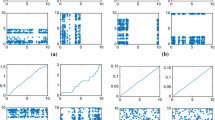Abstract
It is well-known that fractional Poisson processes (FPP) constitute an important example of a non-Markovian structure. That is, the FPP has no Markov semigroup associated via the customary Chapman–Kolmogorov equation. This is physically interpreted as the existence of a memory effect. Here, solving a difference-differential equation, we construct a family of contraction semigroups \((T_\alpha )_{\alpha \in ]0,1]}\), \(T_\alpha =(T_\alpha (t))_{t\ge 0}\). If \(C([0,\infty [,B(X))\) denotes the Banach space of continuous maps from \([0,\infty [\) into the Banach space of endomorphisms of a Banach space X, it holds that \(T_\alpha \in C([0,\infty [,B(X))\) and \(\alpha \mapsto T_\alpha \) is a continuous map from ]0, 1] into \(C([0,\infty [,B(X))\). Moreover, \(T_1\) becomes the Markov semigroup of a Poisson process.
Similar content being viewed by others
References
Arendt, W., Batty, C., Hieber, M., Neubrander, F.: Vector-Valued Laplace Transforms and Cauchy Problems. Monographs in mathematics, vol. 96. Birkhäuser, Basel (2001)
Barrachina, X., Peris, A.: Distributionally chaotic translation semigroups. J. Differ. Equ. Appl. 18(4), 751–761 (2012)
Beghin, L., Orsingher, E.: Fractional Poisson processes and related random motions. Electron. J. Probab. 14, 1790–1826 (2009)
Beghin, L., Orsingher, E.: Poisson-type processes governed by fractional and higher-order recursive differential equations. Electron. J. Probab. 15, 684–709 (2010)
Ethier, S.N., Kurtz, T.G.: Markov Processes: Characterization and Convergence. Wiley, New York (1986)
Gorenflo, R., Mainardi, F.: Fractional Calculus: Integral and Differential Equations of Fractional Order. CISM lecture notes (2008). arXiv:0805.3823
Grosse-Erdmann, K.G., Peris, A.: Linear Chaos. Universitext. Springer, Berlin (2011)
Jumarie, G.: Fractional master equation: non-standard analysis and Liouville–Riemann derivative. Chaos Solitons Fractals 12, 2577–2587 (2001)
Kilbas, A., Srivastava, H., Trujillo, J.: Theory and Applications of Fractional Differential Equations. North-Holland mathematics studies, vol. 204. Elsevier, Amsterdam (2006)
Laskin, N.: Fractional Poisson process. Commun. Nonlinear Sci. Numer. Simul. 8, 201–213 (2003)
Laskin, N.: Some applications of the fractional Poisson probability distribution. J. Math. Phys 50, 113513 (2009). https://doi.org/10.1063/1.3255535
Lizama, C.: The Poisson distribution, abstract fractional difference equations, and stability. Proc. Am. Math. Soc. 145(9), 3809–3827 (2017)
Mainardi, F., Gorenflo, R., Scalas, E.: A fractional generalization of the Poisson processes. Vietnam J. Math. 32, 53–64 (2004)
Mainardi, F., Gorenflo, R., Vivoli, A.: Beyond the Poisson renewal process: a tutorial survey. J. Comput. Appl. Math. 205, 725–735 (2007)
Meerschaert, M.M., Nane, E., Vellaisamy, P.: The fractional Poisson process and the inverse stable subordinator. Electron. J. Probab. 16, 1600–1620 (2011)
Pazy, A.: Semigroups of Linear Operators and Applications to Partial Differential Equations. Applied mathematical sciences, vol. 44. Springer, New York (1983)
Podlubny, I.: Fractional Differential Equations. Mathematics in science and engineering, vol. 198. Academic Press Inc., San Diego (1999)
Prüss, J.: Evolutionary Integral Equations and Applications. Birkhäuser, Basel (1993)
Repin, O.N., Saichev, A.I.: Fractional Poisson law. Radiophys. Quantum Electron. 43, 738–741 (2000)
Samko, S.-G., Kilbas, A., Marichev, O.: Fractional Integrals and Derivatives. Gordon and Breach Science Publishers, Yverdon (1993)
Uchaikin, V.V., Cahoy, D.O., Sibatov, R.T.: Fractional processes: from Poisson to branching one. Int. J. Bifur. Chaos Appl. Sci. Eng. 18, 2717–2725 (2008)
Author information
Authors and Affiliations
Corresponding author
Additional information
Communicated by Behrndt, Colombo and Naboko.
Appendix
Appendix
Lemma 3.1
Consider the probability measure \(\mu (dt)=e^{-t}dt\) on the positive real line. Let be given a sequence \((h_n)_{n\in \mathbb {N}}\) of positive integrable functions such that
- (H1):
-
\(h_n (t)\rightarrow h(t)\) almost everywhere as \(n\rightarrow \infty \), h integrable, and
- (H2):
-
\(\int _0^\infty h_n(t)\mu (dt)\rightarrow \int _0^\infty h(t)\mu (dt)\).
Then \((h_n)_{n\in \mathbb {N}}\) is uniformly integrable and \(h_n\rightarrow h\) in \(L^1(\mu )\).
Proof
Take \(c>0\). Then \(h_n1_{\{h_n\le c\}}\rightarrow h1_{\{h\le c\}}\), a.e. by (H1) and \(h_n1_{\{h_n\le c\}}\le c\). Thus, Lebesgue’s dominated convergence theorem implies that
And (H2) yields
So that \(\limsup _n \int _{\{h_n>c\}}h_n(t)\mu (dt)=\int _{\{h>c\}}h(t)\mu (dt).\) Given \(\epsilon >0\), choose \(c_0>0\) to have
and there exists \(n_0\) such that \( \sup _{n\ge n_0}\int _{\{h_n>c_0\}}h_n(t)\mu (dt)<\epsilon .\) Since any finite family of integrable functions is uniformly integrable, so is \((h_1,\ldots ,h_{n_0-1})\), and one obtains the same property for the whole sequence \((h_n)_{n\in \mathbb {N}}\). Finally, the family \((h_n-h)_{n\in \mathbb {N}}\) is uniformly integrable as well, and this sequence converges to 0 a.e. Therefore, \(\Vert h_n-h\Vert _1\rightarrow 0\). \(\square \)
Rights and permissions
About this article
Cite this article
Lizama, C., Rebolledo, R. A Semigroup Approach to Fractional Poisson Processes. Complex Anal. Oper. Theory 12, 777–785 (2018). https://doi.org/10.1007/s11785-018-0763-z
Received:
Accepted:
Published:
Issue Date:
DOI: https://doi.org/10.1007/s11785-018-0763-z




